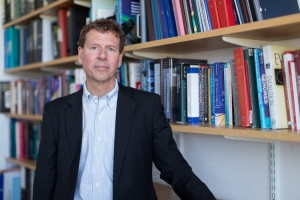Seminar by Prof. Paul Matthews (Aug. 27)
・Date: Thursday, August 27, 2015
・Time: 4:00 pm‐5:30 pm
・Venue: Conference Room (3rd Floor), Tohoku Medical Megabank Building
・Title: The Imaging Enhancement and UK Biobank: an unprecedented effort for new knowledge about late life disease
・Lecturer: Prof. Paul M. Matthews (UK biobank, Imperial College London)
・Abstract: It now is well recognised that MRI methods provide powerful measures for precise phenotypic characterisation that can be applied to discover markers of disease or disease risk factors. Building on advances in automated quantitative analyses, large scale imaging studies have now been developed in a number of collaborations. Together, these developments are creating a new “imaging epidemiology”.
The most ambitious of large scale population imaging studies to date is being developed within the UK Biobank (www.ukbiobank.ac.uk), a large prospective cohort that was established by the UK Medical Research Council and the Wellcome Trust as a resource for the investigation of risk factors for major diseases and morbidities of middle and older age. It includes 500,000 men and women now aged approximately 50-80 years old, who were recruited nationwide between 2006 and 2010 for serial assessments until death. The baseline assessment was extensive, with detailed information gathered on prevalent disease, diet, lifestyle, socioeconomic factors, education, medications/supplements and specific measurements such as blood pressure, weight, height, bio-impedance, grip strength and ultrasound measures of heel bone density and cognitive testing. Venous blood samples were collected and results of a panel of standard biochemical, haematological and immunological assays will be available soon. Chip-based genotyping data on 150,000 subjects became available in late Spring, 2015 and the remainder of the cohort will be genotyped by the end of this year. The baseline assessment is being repeated every few years in subsets of approximately 20,000 participants to enable calibration of measurements, adjustment for regression dilution and estimation of longitudinal change. The UK Biobank database is linked with UK National Health Service administrative information systems in order to capture data relating to incident disease outcomes.
The UK Biobank thus combines an unprecedented size (similar efforts have been developed in China since), breadth and depth for a prospective longitudinal cohort study. As incident cases accrue, it will allow a broad range of health outcomes- particularly including those for late life brain diseases- to be related to a uniquely broad range of risk factors through case-control studies “nested” within the overall cohort.
In 2014, a pilot of an Imaging Enhancement was initiated. The objective of the Enhancement is to provide a comprehensive imaging assessment that will include 3T MRI of the brain including advanced DTI and resting state fMRI for connectivity analysis; 1.5T MRI of the heart and upper abdomen; carotid doppler and DEXA of whole body, on a total of 100,000 participants across England. The first stage of the project, which has generated high quality image datasets on approximately 4,000 subjects to date, is to optimise processes, explore ethical issues and evaluate the feasibility of this complex, high throughput imaging. Subject to approval of the progress by the funders, the full programme, moving towards imaging a full 100,000 will be initiated from early 2016 and is expected to last a further 6 years. The breadth of phenotypic information in such a large cohort will yield a unique opportunity to apply MRI in the context of other techniques to investigate risk factors for disease both within and across organ systems.
The large size of the cohort was based on statistical power calculations for nested case-control studies, showing that 5-10,000 cases of any particular condition would be required for the reliable detection of odds ratios (ORs) of 1.3-1.5 for the main effects of different exposures (the upper end of the range reported from genome-wide association studies of various conditions), and around 20,000 cases for interactive ORs of 2.0 or more. The objective is not to use the resource in a single investigation, but to enable the generation of nested case-control studies, each of which is individually powered to address an important question.
An important aspect of UK Biobank is that it has been developed by a broad community working together. It was established and is now being enhanced as a result of the altruism and generosity of its participants, the long-term vision of its major funders, an approach involving streamlined governance, centralised infrastructure, “industrial” methods for collection and processing of data and samples, effective working between academic and management disciplines, and widespread public support. What is very special is the resolute focus is on encouraging extensive use of the resource, which will become available to the international research community without preferential or exclusive access.
・Organizer: Prof. Yasuyuki Taki

